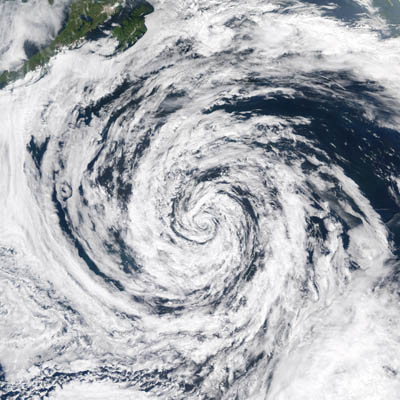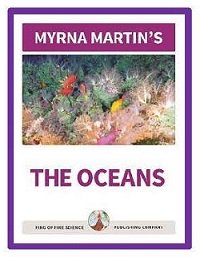Formation of Hurricanes
Pacific Ocean
Introduction
Formation of hurricanes in the northeast Pacific Ocean were not officially recognized until the 1920s. Most hurricanes move across the oceans from east to west because prevailing winds travel in that direction.
Increased shipping along the west coast of Mexico and the United States alerted meteorologists to the number of hurricane force storms formed in the north eastern Pacific Ocean.
Today it is recognize that this basin is the second most active basin for formation of hurricanes on our planet. The north western Pacific Ocean basin that includes the Philippines and Japan is the most active for formation of hurricanes.

Formation of Hurricanes
Tropical cyclones
Tropical cyclones is a generic term for swirling storms in the ocean. The average number of tropical cyclones that form each year is 86. Forty-seven of these storms grow large enough to become hurricanes/typhoons. About 20 of these storms will increase in strength and intensity to become a Category 3 storm.


Click for More Information and to Order
Early
reports of hurricanes in North Pacific Ocean
The Spaniards living in Mexico were the first to report the formation of hurricanes that were striking the country in 1730. They wrote about the whirling winds as they came ashore. In the middle of the 19th century meteorologist William Redfield noted that between June and October of 1850 there were five tropical cyclones that came ashore along the southwestern coast of North America. The formation of hurricanes and other storms continued to be documented during the century but most meteorologists still did not recognize that hurricanes would make landfall on the eastern shores of the Pacific Ocean.
Shipping increases on the west coast
The gold rush in California in 1848 created a need for many ships to travel along the coasts of Central and North America. Gold miners going to San Francisco to mine for gold preferred to travel by boat on their journey to the gold fields. Shipping freight and travel also increased after the Panama Canal was opened in 1914. The canal shortened the trip from the east coast to the west coast and was much safer than going around the tip of South America.
Captains radio reports of major storms at sea
Ship captains reported major storms they encountered as they traveled northward toward different ports on the west coast. By the 1920s Pacific hurricanes were officially recognized by the US Weather Bureau. Today the North Eastern Pacific basin is known to be the 2nd most active on our planet.
Hurricane basins in the North Pacific Ocean
There are two major hurricane basins in the North Pacific Ocean. Hurricanes are tropical cyclones that occur along the coast of Central America and Mexico when they develop north of the equator. Typhoons are the exact same storms forming across the International Dateline north of the equator in the western Pacific Ocean.
Seven tropical cyclone basins
The United States Weather Bureau in 1913 recognized five tropical cyclone basins. They did not recognize the Eastern North Pacific basin at that time. Today the US Weather Bureau recognizes seven basins. The North Eastern Pacific basin is now recognized officially and is the second most active tropical cyclone basin worldwide. The most active basin is the North Western Pacific basin. The least active basin is the north Indian Ocean which includes the Arabian Sea and the Bay of Bengal.
Hurricane season
The North Pacific hurricane season runs from May 15 through November 30th each year. There are on average 16 tropical storms that form in the basin each year. Nine of the storms become hurricanes and four of them become major hurricanes. The hurricane center that monitors the area issues reports, watches and warnings to ships and areas where the storms will make landfall.
Prevailing winds in the North Pacific
The winds in the tropical areas of the Pacific Ocean and Atlantic Ocean generally blows from east to west. This causes hurricanes in the Atlantic Ocean to blow toward the North American continent. These prevailing winds that blow storms landward in the eastern and southern parts of the United States make landfall on average about twice a year. The hurricanes that develop in the North Pacific Ocean generally blow the storms away from the land out to sea.
Pacific Ocean typhoons
More hurricanes/typhoons occur in the Pacific Ocean than anywhere else on earth. The western part of the Pacific Ocean northeast of the Philippines is the most active place on Earth for typhoons. Nearly one third of all tropical cyclones occur in this basin.
Hurricanes on the Pacific Ocean
The eastern basin of the North Pacific Ocean is the second most active area on our planet. There are on average 16 tropical storms annually. Nine of these storms grow into hurricanes. Four of the hurricanes increase in strength into major hurricanes.
Where the storms usually make landfall
Most hurricanes in the Eastern North Pacific move out to sea without harming any land areas. Occasionally they recurve to the north or northeast where they will strike Central America or Mexico. Mexico and the Revillagigedo Islands are frequently in the path of these hurricanes. Hurricanes that strike the west coast usually occur either early or late in the hurricane season.
Cold ocean waters protect California
California has had only one recorded hurricane strike the coast in the 200 years that the storms have been monitored. A hurricane in 1858 struck San Diego with gale force winds strong enough to rip off roofs of houses, uproot trees and destroy fences. The winds that carry hurricanes western on the East Coast carry them away from the west coast on the other side of the country. Another factor that keeps hurricanes from striking the coast is the cold ocean current that flows from the north southward along the coast of Washington, Oregon and California.
More Weather Links
Weather Facts: The weather affects our everyday lives throughout the year. Use the links on this page to learn about hurricanes, the Earths atmosphere layers, air pressure, lightning and thunderstorms.
Formation of hurricanes in North Pacific Ocean occurs in two basins. They are the two most active basins for cyclones to form on our planet. Meteorologist recognized the north eastern Pacific Ocean basin 1920s.
The Earths atmosphere layers are similar to the interior of the Earth. Find out about the four major layers of atmosphere that are separated by temperature.
What is air pressure? It is the weight of air molecules pressing down on the Earth. The pressure changes as you move upward into the atmosphere.
What causes lightning and what are the warning signs before lightning strikes? Find out on this fascinating page about lightning.
What are thunderstorm clouds and how do they form? Find out how severe thunderstorms produce rain, lightning, hail and occasionally tornadoes.
KIDS FUN Science Bookstore
Check out Myrna Martin's award winning textbooks, e-books, videos and rock sets. The Kids Fun Science Bookstore covers a wide range of earth science topics. Click here to browse.










